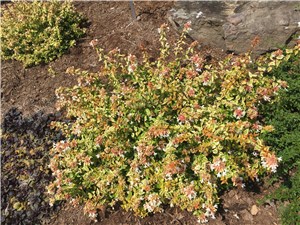Resource Library
Plant of the Week: Abelia Hybrids
Kaleidoscope abelia is a stable, heat tolerant variegated selection that offers an array of bloom and foliage colors as the garden season progresses. (Image courtesy Gerald Klingaman. Credit mandatory.)
Download High Resolution
Gardeners all know abelias because they are the first entry in the plant reference books we all study so reverently. But most southern gardeners consider it hopelessly old fashioned and, until recently, have spurned it in favor of more modern choices. Beginning about 15 years ago, however, abelia was updated by a series of new rounds of hybridization, and what was old is new again.
As many as 30 species of abelias have been described in the honeysuckle family with species found throughout much of Asia and in Mexico. Abelia x grandiflora, the form primarily seen in gardens until recently, was developed at an Italian nursery about 1866 and showed up in the United States about 20 years later. It is a sterile semi-evergreen shrub that flowers from late spring through frost, giving it the longest blooming season of any garden shrub.
But this old abelia was a big rambunctious plant, often growing 8 feet tall and wide in a cascading mound of purple-tinged foliage and pinkish white flowers. In the late 1990s Mike Dirr, the now-retired University of Georgia professor and most influential woody plant expert in the last 40 years, planted seed from Abelia chinensis that was possibly pollinated by a nearby ‘Francis Mason’ abelia. From that open pollinated cross arose two now prominent abelia hybrids, ‘Canyon Creek’ and ‘Rose Creek’.
“Rose Creek” is the most floriferous dwarf abelia of which I am aware, growing to 3 feet tall and wide in eight years. It is covered in small white tubular flowers from July through frost. At the base of each flower is a maroon colored sepal that gives the plant a pinkish glow. The plants I have observed have been extremely uniform with pruning limited to clipping off the remnants of the previous season’s seed pods before new growth starts in the spring. For us in the south end of zone 6 it is mostly deciduous, but in zone 7 it tends to be semi-evergreen, retaining about half of its leaves.
“Kaleidoscope” (PP 16,988) is a well-chosen name for this yellow variegated selection because it changes colors throughout the growing season. It begins the season with bright yellow and green leaves that shift towards maroon and gold with the arrival of cold weather in the fall. It arose as a sport of the green leafed selection called “Little Richard” that is said to grow only 3 feet tall but it appears to me that “Kaleidoscope” will probably be larger given time.
“Pinkie Bells” (PP 20,604) is a new introduction from Spring Meadows Nursery in Michigan that is being promoted through the Proven Winners marketing brand. It is a hybrid of A. schumannii “Bumblebee” with pollen provided by “Little Richard.” The plants I have watched for the past couple years are not especially strong growers but I look forward to it settling in because the pinkish, bell shaped flowers are some of the nicest I have seen.
These are just a few of the 50-plus cultivars of abelia that have suddenly appeared in gardens and nurseries. Because the best gardens are created by using plants with well defined characteristics, do your homework to before plunking down just any old abelia. The right plant (cultivar) in the right place should be the mantra for the modern garden.
Abelias are easy to grow from zone 6 through zone 10, where they perform best in full sun or light shade. Once established they are drought tolerant and not bothered by serious pest problems. The foliage is said to be deer proof, another added bonus. Pruning to control size should be done in late winter with blooms produced on new growth through the summer. Erratic shoots should be pruned as they appear to maintain compact growth for some of the more dwarf forms, though the “Rose Creek” planting I have watched has never shown this tendency.
For more information about horticulture contact your county extension agent.
